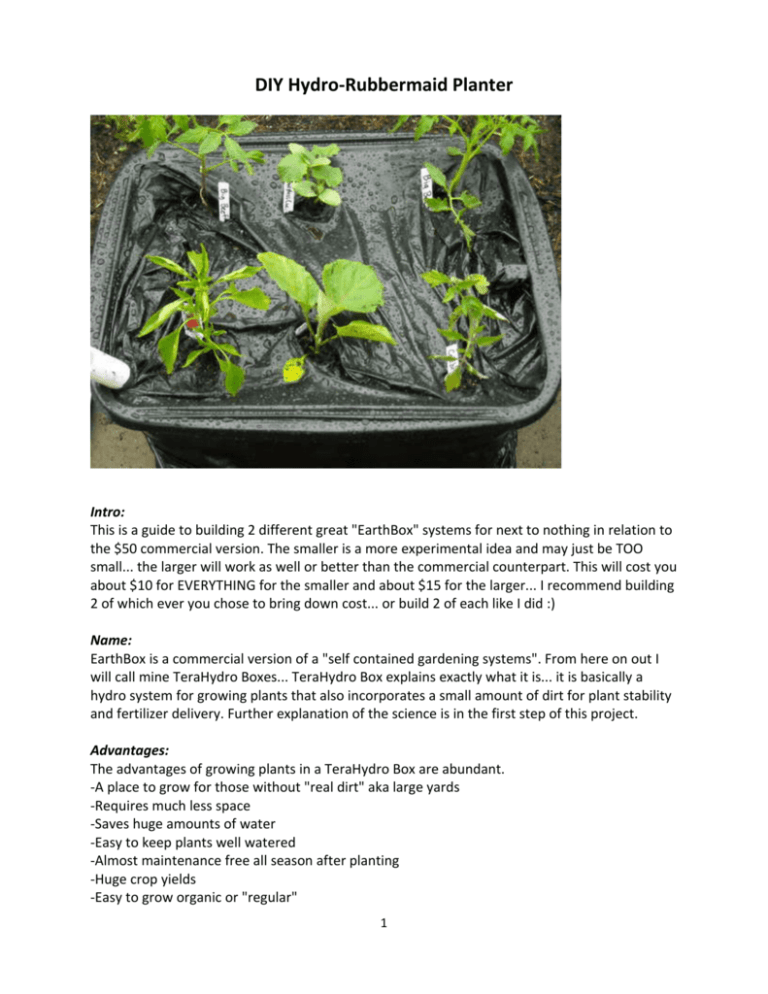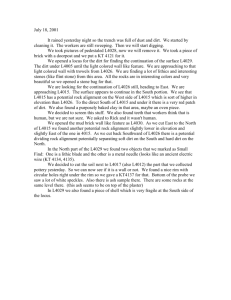DIY Hydro-Rubbermaid Planter
advertisement

DIY Hydro‐Rubbermaid Planter Intro: This is a guide to building 2 different great "EarthBox" systems for next to nothing in relation to the $50 commercial version. The smaller is a more experimental idea and may just be TOO small... the larger will work as well or better than the commercial counterpart. This will cost you about $10 for EVERYTHING for the smaller and about $15 for the larger... I recommend building 2 of which ever you chose to bring down cost... or build 2 of each like I did :) Name: EarthBox is a commercial version of a "self contained gardening systems". From here on out I will call mine TeraHydro Boxes... TeraHydro Box explains exactly what it is... it is basically a hydro system for growing plants that also incorporates a small amount of dirt for plant stability and fertilizer delivery. Further explanation of the science is in the first step of this project. Advantages: The advantages of growing plants in a TeraHydro Box are abundant. ‐A place to grow for those without "real dirt" aka large yards ‐Requires much less space ‐Saves huge amounts of water ‐Easy to keep plants well watered ‐Almost maintenance free all season after planting ‐Huge crop yields ‐Easy to grow organic or "regular" 1 Update!! BOTH the small and large TeraHydro Boxes worked excellent. The Large TeraHydro Box worked much better than the original Earth Box even!! I harvested gallons and gallons of salsa. Way too much in fact, haha... While I still recommend 6 tomato plants for the large THB, 2 would be better for the small one. Six plants was just too much vegetation for such a small area and the plants were a little small from not getting enough light. Step 1 : How it Works Here is an explanation or TetraHydro Boxes and how they work. The first image is a cutaway that helps you understand what I am saying if you have never seen one. Essentially, you have a large plastic tub, with a water reservoir in the bottom, dirt on top with a huge strip of fertilizer, and the whole thing acts similar to a hydro system for growing plants and vegetables. If you don't know what hydro growing is, the short and sweet version is: it is a growing system with no dirt that allows the roots to grow in a large bucket of fertilized water. After taking apart an Earthbox after a season of growth I discovered all of the roots had reached the water reservoir and were doing just that. NOTE: whether you use my build design or not there are two things I know are very important that most other guides overlook. In order for the "hydro" part of the earth box to work the water reservoir has to be absolutely dark, to promote roots and discourage algae, and there also must be tons of holes in whatever device you use to separate the water and dirt. Otherwise you end up with wet dirt, like you needed, but root bound plants which is not as good for plant health. For example... Earth boxes recommends only 2 tomato plants per box, yet I have grown 6, even in their box, with tons of success so that is how I do it now. Perhaps they have a reason, or think they have a reason for why you should only plant 2 plants, but I think it’s just to sell more 2 boxes... lol... a lot of the things they recommend doesn't seem like there is a real solid reason though... I think they pushed the product to market as fast as possible and did not get real exact on how or why you should plant things a certain way. The majority seems like educated guesses from smart people, so I use their instructions as a guide and experiment with my own ideas too. Step 2 : Material List I will simultaneously explain how to build 2 different TetraHydro Boxes and I recommend you build 2 of whichever you choose. I have been pushing the limits on the Earthbox since I got it to see how much it can grow, and know that the large TetraHydro Box can grow 6 tomato plants!! But the small TetraHydro box can only do 2. Everything is nationally available and purchasable at Wal‐Mart and Home Depot. First is the list for each box system and below is a more detail description with important notes on items like the fertilizer and dirt. 3 Large TetraHydro Box: ‐Large 18 gallon storage bin (Wal‐Mart $4) ‐Steralyte plastic basket w/ holes (Wal‐Mart 2 for $3) ‐2 cubic feet of potting soil (Gardeners Brand Composted Planting Mix Lowe's $5) ‐2 cups of fertilizer (16‐16‐16 Schults, Home Depot $12 for HUGE 15lbs bag,) ‐2 cups of garden lime (Organic Traditions, Home Depot 10 cup bag $3.50) ‐About 1 foot of 1 inch pvc each (Home Depot $2.5 for 10 feet) ‐6 inch scrap of any rubber tubing for drain ‐Large trash bag ‐Veggies! 4 Small TetraHydro Box: ‐Small 18 quart dish bin (Wal‐Mart $3) ‐Drawer organizer plastic basket w/ holes (Wal‐Mart 2 for $1) ‐1/2 cubic foot of potting soil (this brand at Lowe's $2.5 for 1ft, but find it at Home Depot also) ‐1 cups of fertilizer (Home Depot $12 for HUGE 15lbs. bag, you can buy way smaller) ‐1 cups of garden lime (Home Depot 10 cup bag $3.50) ‐About 1 foot of 1 inch pvc each (Home Depot $2.5 for 10 feet) ‐6 scrap of any rubber tubing for drain ‐Large trash bag ‐Veggies! Details: ‐Box Nothing too specific make sure its large enough and will hold the basket with holes in it upside down. If you don't buy the suggested bin you will have a good understanding of how to pick your own by the end of the guide. ‐Basket Make sure it fits in your box upside down. You are going to drill holes in the bottom later so it will act as a membrane between dirt and water but allow the roots to penetrate. ‐Dirt Earthbox recommends or more requires that you only use potting MIX... I use SOIL... either is fine... mix just costs more. The difference I do know is that potting MIX has already been fertilized and they add perlite. Perhaps that is worth paying double for, I don't know though. I've used them both in separate boxes simultaneously and noticed no difference. ‐Fertilizer: Earthbox says any fertilizer will work as long as the numbers are 15 or less, as in 5‐8‐12 or some 5 combination. The one I am using is 16‐16‐16. I guess I am just defiant... lol :) ‐Garden lime Very hard to find! Strange considering how important it is for gardening though. Earthbox recommends you use dolomite or hydrated lime. The brand I found at Home Depot was cheap enough and has way more benefits too. The purpose is to raise the soil ph as most vegetables need more acidic soil and also to fortify the soil with calcium. Without it your plants may suffer from what is called blossom end rot and it ruins you crop. I have seen it personally and would add the vitamin tablets of calcium or crushed egg shells afterward, but the garden lime I found has tons of other vitamins and minerals too. Step 3 : Begin! Drill Holes 6 Drill holes all throughout the bottom of your basket I'd say anything between a 1/4" and 3/8" are good... I used a step bit so mine came out random sizes. Step 4 : Cut PVC, and begin assembly 7 Cut your 1" pvc so that it is long enough to reach from the bottom of your box and stick out a few inches. Notch/Wedge the end if you like to make sure it won't sit flat on the bottom and get clogged. Next put your basket into your box upside down and cut a corner of the basket to penetrate the pvc through. 8 Step 5 : Drain hole It is important to put your drain hole at the top of where your water line should be. So put it at the top of the basket. A simple hole in the side will clog with dirt a little and drain slower, so I used a small rubber auto hose to "bring" my drain hole inside the basket as pictured. Try to make the hole in the side the same size as your drain hose but there is no reason to make it a perfect fit or seal it of...lol... it’s a drain! :) 9 Step 6 : DIRT! :) Fill the box halfway with dirt. To keep as little dirt as possible from entering the reservoir it is better to dump the dirt in fast instead of slow. For the large boxes the take 1 cubic feet of dirt that means add a whole 1 cubic foot bag right now, and for the smaller boxes it only takes 1/4 cubic foot. Next, fill the reservoir with water till it starts coming out your drain hole. Then thoroughly soak the dirt down for at least 60 seconds so it is completely drenched throughout. You can even "massage" the dirt a little with your hands to get it to soak in everywhere. Now add 1/2 the garden lime for the large TetraHydro Box, 1 cup, and all of it for the small box,. also 1 cup. Next, add the rest of the dirt to top off your box and soak the dirt for another 60 seconds. 10 Step 7 : Fertilizer Strip For the small TetraHydro Box there is no garden lime left to add, but for the large box and the rest of the garden lime and for both add your strip of fertilizer. Earthbox recommends different arrangements for different plants, but personally I always grow 6 plants with a strip in the middle. They recommend 2 tomato plants but I have grown 6. Usually I like to mix and match though. Like 4 tomatoes, a pepper and a large leafy plant like squash or cucumber. In any case... dig your small trench and add all of the fertilizer. Cover the fertilizer again and when you add the plants try not to disturb the fertilizer strip at all. 11 Earthbox Recommended Plant & Fertilizer Placement Chart Use this guide to purchase the correct number of seedlings for the type of plants you wish to grow. The patterns shown below illustrate the best placement of plants and fertilizer based on the suggested number of plants per variety as listed above. Single Row (2 seedlings per row) (4 seedlings per row) Artichokes, Eggplants, Tomatoes, Zucchini Cucumbers, Melons, Squash (vining) Double Row (3 seedlings per row) (4 seedlings per row) Bell Peppers, Broccoli, Brussels Sprouts, Cabbage, Cauliflower, Celery, Chard, Greens, Herbs, Hot Peppers, Strawberries Beans (bush), Flowers, Kohlrabi, Leeks, Lettuce, Okra, Salad Greens (5 seedlings per row) (8 seedlings per row) Beets, Onions, Spinach, Turnips Beans (pole), Carrots, Corn, Garlic, Peas, 12 Radishes Step 8 : Add cover 13 Stretch a large thick trash bag over as a cover. For the large TetraHydro Boxes this is a little difficult. Once the bag is over, poke holes thru so the watering pipe can come through and to lay out your plants. Make the holes as small as possible. Step 9 : Add your vegetables! Since the small boxes are more experimental I added 4 tomatoes to one and 6 to the other. We'll see what it can handle. With the large boxes though I know it can handle 6 tomatoes even so one has 4 tomatoes, an eggplant and a cucumber, and the other has 3 tomatoes, a squash, and a cucumber, with one more spot awaiting a pepper probably :) Enjoy your veggies! :) 14



